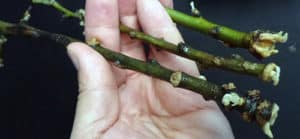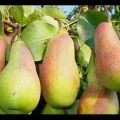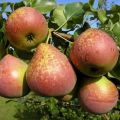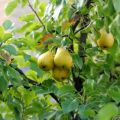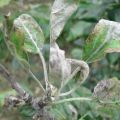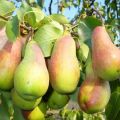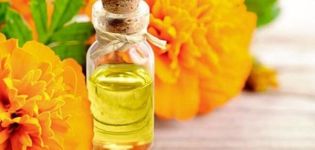Full characteristics and description of the columnar pear variety Medovaya, planting and care
The Honey pear variety has long been known to gardeners. Small trees yield up to 35 kilograms of fruit per season. The fruits of the Honey pear are juicy, sweet and large. The branches are abundantly strewn with ripening fruits, bending under their weight. By the end of September, the fruits ripen, they have to be picked by hand. To ensure a high yield in early spring, the tree must be fed with organic matter, and before flowering, it must be treated with fungicides and insecticides.
Detailed description and characteristics of the variety
In the sixties of the last century, a honey pear was brought out at the Crimean gardening station. The first name is Crimean Honey. A new type of pear was obtained by free pollination of the famous French variety - Bere Bosc.
It is advisable to grow honey in regions with a warm climate. With proper shelter for the winter, this variety can grow in Central Russia. Pear is a cold-resistant culture, it tolerates short-term frosts of 20 degrees well.
A tree with a pyramidal, not very dense crown, "stretches" up to 2.15 meters in height. Fruits ripen in autumn (late September). Fruiting occurs, as a rule, in 3-5 years. Honey is considered to be a partially self-fertile crop. For better pollination, it is recommended to plant at least two pollinating trees nearby, for example, the Chudesnitsa variety, Bere Bosk.
Pollinators must have the same flowering and ripening periods.
Honey's fruits are not small, weighing 345-525 grams. The fruit is pear-shaped, uneven, and bumpy in places. A ripe pear has a yellowish-green color with a light brown blush. On its smooth thin skin, gray-green, tiny dots are visible. The pulp is sweetish, with a honey flavor, melts in the mouth. The fruits contain a high percentage of sugar and vitamin C.
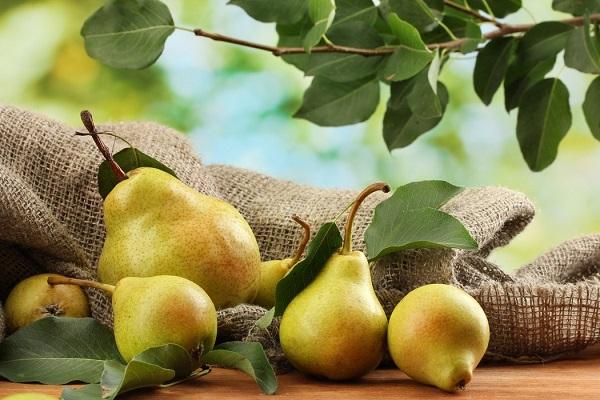
Pear - juicy, tender, aromatic, slightly oily, with creamy pulp. Ripe fruits do not fall off the branches, they have to be picked by hand. Pears ripen by the end of September. Up to 37 kilograms of sweet fruits can be harvested from one small tree.
About twenty years ago, a columnar variety of Honey was bred. Its fruit tastes the same as the main variety. The columnar pear has a straight trunk up to 1.95 meters high, there is no spreading crown, all branches are pressed against the main trunk.
Productivity - 15-25 kilograms from one tree.Several subspecies of the columnar pear have been bred. Fruits of different varieties ripen at different times - from August to October. There are autumn and summer varieties of honey columnar pear.

The main pros and cons of honey pear
Positive qualities of culture:
- early maturity (fruiting for 3 years);
- compact type of tree;
- annual, consistently high yield;
- excellent taste and market characteristics of ripe pears;
- the possibility of long-term storage of the harvested crop;
- unpretentious care;
- good immunity to many diseases.
Disadvantages:
- low frost resistance;
- fruits of different sizes at the time of ripening;
- the need for crown formation.
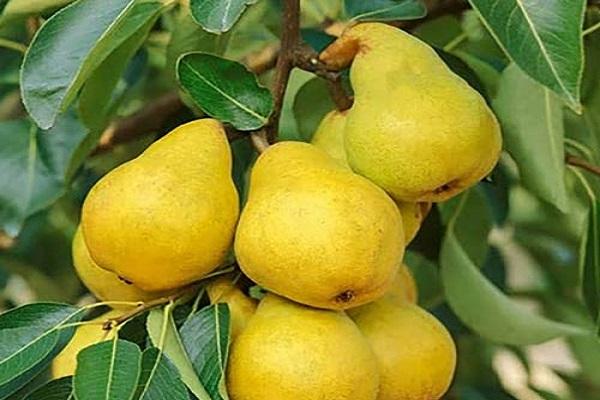
Subspecies of the proposed variety
Several columnar varieties have been bred on the basis of Medovaya. All subspecies have been assigned a marking class "G". The columnar tree has no horizontally branching branches, it grows up to 1.95 meters in height, all its branches are pressed against the main trunk. Columnar pear does not need crown formation.
Subspecies of columnar pear:
- G1 - winter variety, fruits - yellowish, lumpy, weighing up to 245 grams;
- G2 - late autumn variety, fruits - yellowish-green, with an orange-brown blush, bumpy, weighing up to 205 grams;
- G3 - early autumn variety, fruits - bright yellow, weighing up to 405 grams;
- G4 - autumn variety, fruits - large, wide, weighing up to 305 grams;
- G5 is a late-growing variety, fruits are yellowish-brown, weighing up to 245 grams.
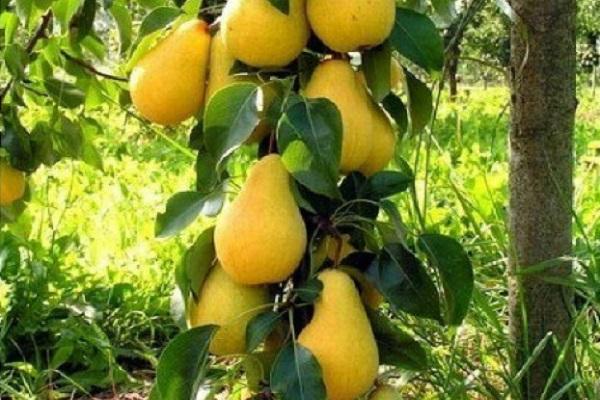
Features of growing crops
The pear can be planted in your garden. First you need to buy a seedling 1-2 years old in the nursery.
Disembarkation dates
The tree can be planted in early spring (in April) - before bud break or in autumn (in September-October) - a month before frost. In regions with cool winters, autumn planting is practiced. In a cold climatic zone, it is better to plant a pear in spring. After all, if a planted tree does not have time to take root before the onset of frost, then it will die. For spring planting, preparatory work is carried out in the fall. For the autumn, on the contrary, - in the spring.
Place selection
The pear does not tolerate transplants, it is immediately recommended to plant the tree in a permanent place. An area well lit by the sun and protected from the cold north wind is suitable. It is undesirable to plant a tree in a swampy area; from strong waterlogging, the roots will begin to rot.
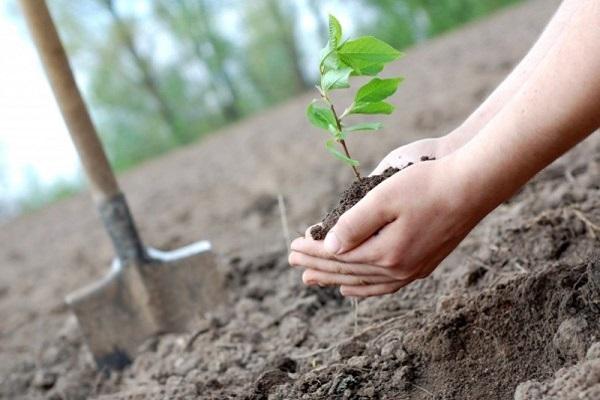
The Medovaya variety does not tolerate acidic soils. Before planting, the soil must be limed, diluted with peat and sand, add 1-2 buckets of humus, 200 grams of wood ash, 100 grams of potassium sulfate and superphosphate.
Seedling preparation
For planting, seedlings that are only 1-2 years old are suitable. After all, the older the tree, the worse it takes root. The maximum age of a seedling is 3 years. Young trees have the best adaptability. An annual seedling should have a height of 0.95 meters, a trunk thickness of 12 millimeters. There should be no branches on a young tree.
A two-year-old seedling has a length of 1.65 meters and 3-5 branches. From the middle of the trunk to the very top, there should be kidneys. The root system can consist of three main and many small roots, be developed, resilient, healthy. Free from bulges and build-ups. The length of the roots is 22-30 centimeters. Before planting, the seedling can be placed in a bucket of water and Kornevin or Heteroauxin for 23 hours.

Planting process
For a pear, you must first (a month before planting) prepare a hole 0.95 meters deep, 60-80 centimeters wide. The excavated earth is diluted with peat and sand, organic and mineral substances are also added. Then the soil is poured back into the hole with a mound, a seedling is placed on top, the roots are straightened, and the remaining earth is sprinkled.
The root collar should be 5-6.5 centimeters above the soil level. The ground near the tree is lightly tamped and watered (1.5-2 buckets).
Before planting, a peg can be inserted into the very center of the pit to support and protect the young thin seedling.
Pollinators
Honey is a partially self-fertile variety. To obtain a high yield, it is recommended to plant 2-3 pollinators near this tree. Suitable varieties: Chudesnitsa, Tavricheskaya, Bore Bosk, Bere Ardapon. Pollinators must have the same flowering and ripening periods.
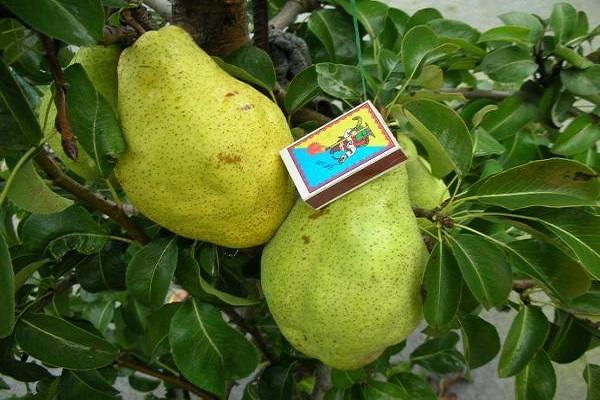
Wood care advice
The pear requires watering, timely feeding, sanitary pruning and crown formation. It is advisable to insulate the tree for the winter.
Watering frequency and well care
Immediately after planting, the tree is watered every week. For irrigation use settled rainwater. 1-2 buckets of water are poured under the root. An adult pear is watered in dry and hot weather, during flowering and ovary formation. After watering, the soil is loosened, the soil crust is broken, and weeds are removed. In order to retain moisture longer, the soil surface can be mulched with sawdust or peat, hay. In rainy weather, the pear is not watered.
Pruning
It is recommended to carry out pruning in spring (in March) - before the juices start moving. The first time the trees are cut only in the second year after planting. The central trunk and lateral branches are slightly shortened (by a third of the length). First, you need to leave 2-3 main (skeletal) branches on the tree, over the years, their number increases to 5-6. The branches that thicken the crown are cut into a ring. In the fall, after the fall of leaves, sanitary pruning of the tree is carried out. Sick, broken branches are cut off. Places of cuts are treated with copper sulfate, garden var.
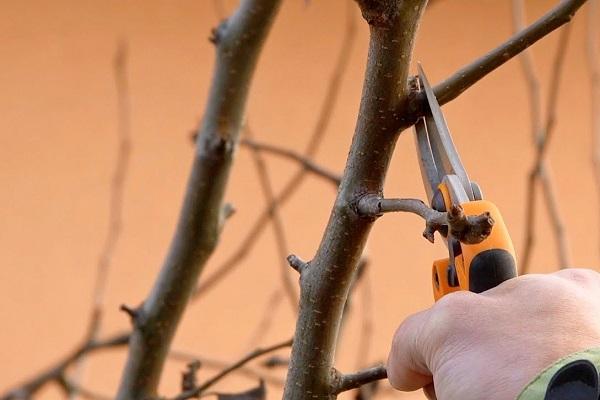
First bloom
In a young seedling planted in spring, you need to cut off all the flowers so that the nutrients go to the formation of new branches and leaves, and not to the development of fruits. For the next season, you can leave half of the blossoming flowers and a few ovaries.
Preparing for winter
Before the onset of cold weather (in November), the pear needs to be whitewashed with lime, fed with organic and mineral substances, watered well (2 buckets of water), and before frost - insulated. Good winter hardiness is facilitated by the introduction of potassium-phosphorus dressings. The trunk circle can be mulched with humus mixed with peat, covered with spruce branches. The trunk itself can be wrapped with burlap and agrofibre. In winter, you need to add more snow to the tree all the time.
Top dressing and effective fertilizers
The pear can be fed in the second year after planting. In the spring, the culture is fertilized with humus (1.5-2 kilograms per tree). Before flowering, the pear is fed with potassium chloride and superphosphate (35 grams of the substance is diluted with ten liters of water). It is useful to fertilize the tree with nitroammophos (50 grams per ten liters of liquid).
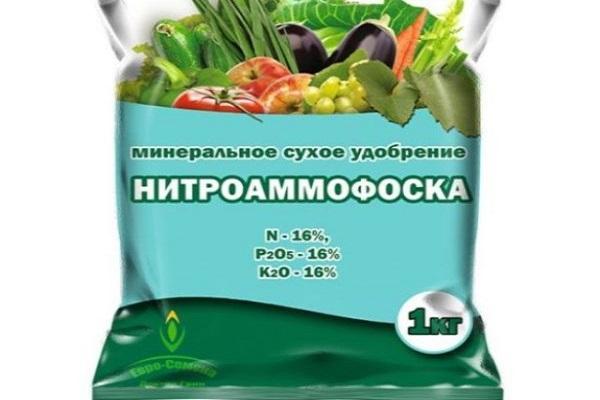
In summer, during loosening, 210 grams of wood ash can be added to the trunk circle. Before wintering, the tree is fertilized with potassium sulfate, superphosphate. For the winter, it is advisable to mulch the trunk circle with peat and humus.
Diseases, main pests and best methods of dealing with them
Common tree diseases: scab (brown spots on leaves), rust (bright orange spots on leaf plates), fruit rot (fruit rot). The pear will hurt less if a number of preventive measures are taken in early spring.
Before budding, the tree must be whitewashed with lime or Bordeaux mixture, the trunk circle must be watered with a solution of copper sulfate. The foliage is sprayed with a fungicide solution in the spring (Skor, Horus, Dnok). Leaf treatments are carried out before flowering, every 10-14 days. Fungicidal preparations are diluted with water according to the instructions; infection control agents can be alternated. Affected leaves, rotting fruits must be plucked and destroyed.
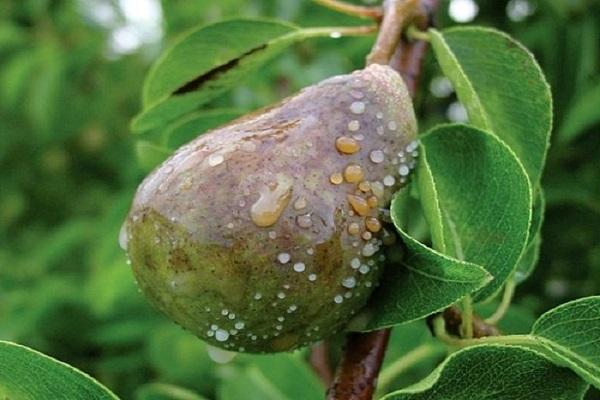
In summer, the pear is often attacked by the honeydew, aphids, and the pear moth.To combat insects, trapping belts are installed on the trunk, and the soil in the near-trunk circle is dug up and watered with insecticides. Before and after flowering, foliage is sprayed with insecticide solutions (Aktara, Fitoverm, Aktellik, Agravertin).
Harvesting and storage of pear harvest
Pears are harvested at the time of technical ripeness. The fruits ripen by the end of September. The fruits do not crumble, they have to be picked by hand, along with the stalk. A ripe fruit should have a juicy, sweet, creamy flesh and a yellowish-brown skin. The harvested pears are placed in boxes and stored in a cool dry room at an air temperature of 1-5 degrees Celsius.
Healthy, whole fruits can last until January. Honey pear is consumed fresh, jams are made from fruits, juices are made. This variety is not suitable for freezing.

